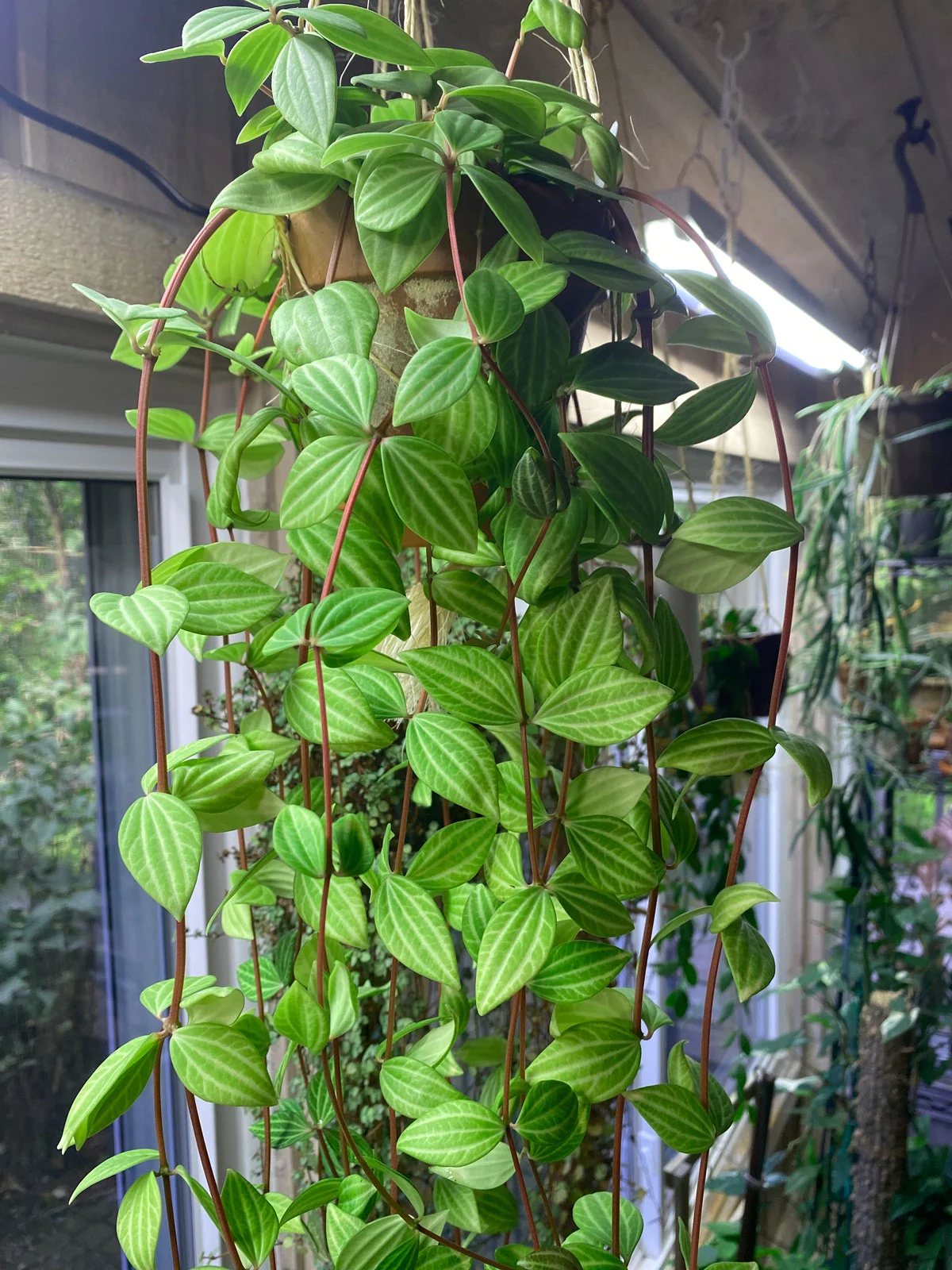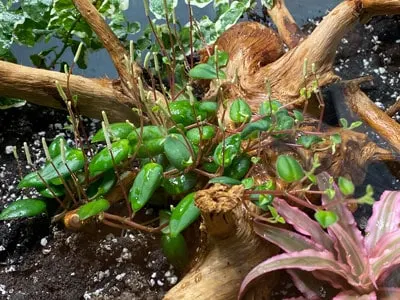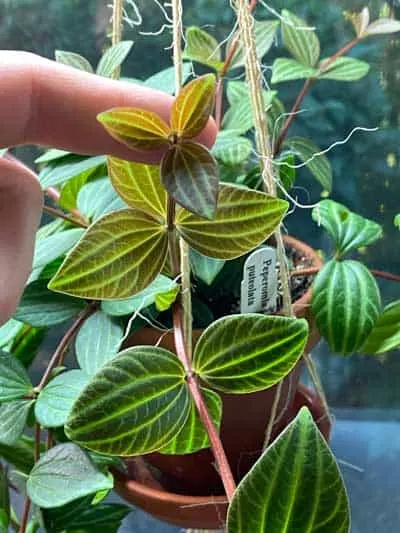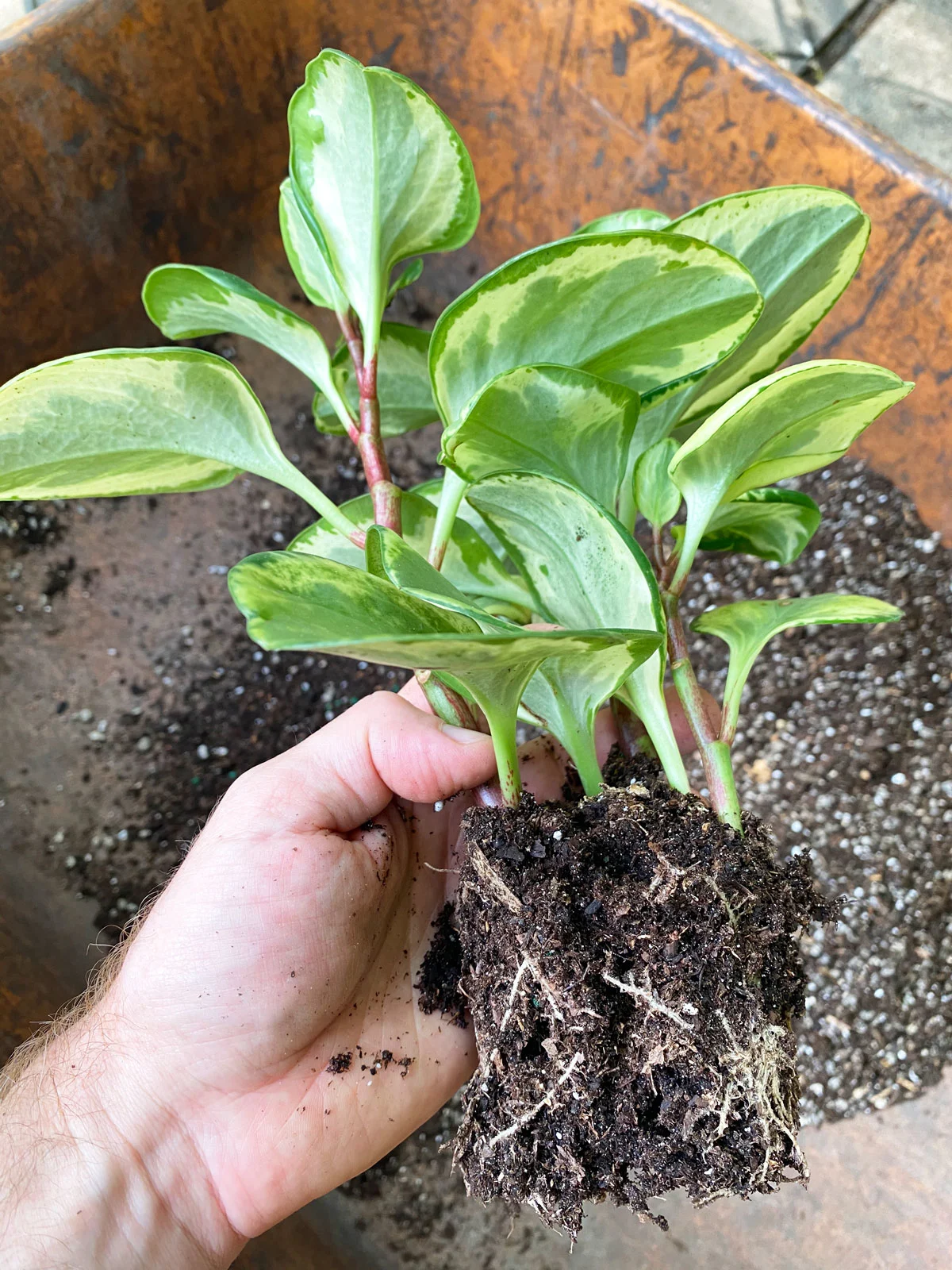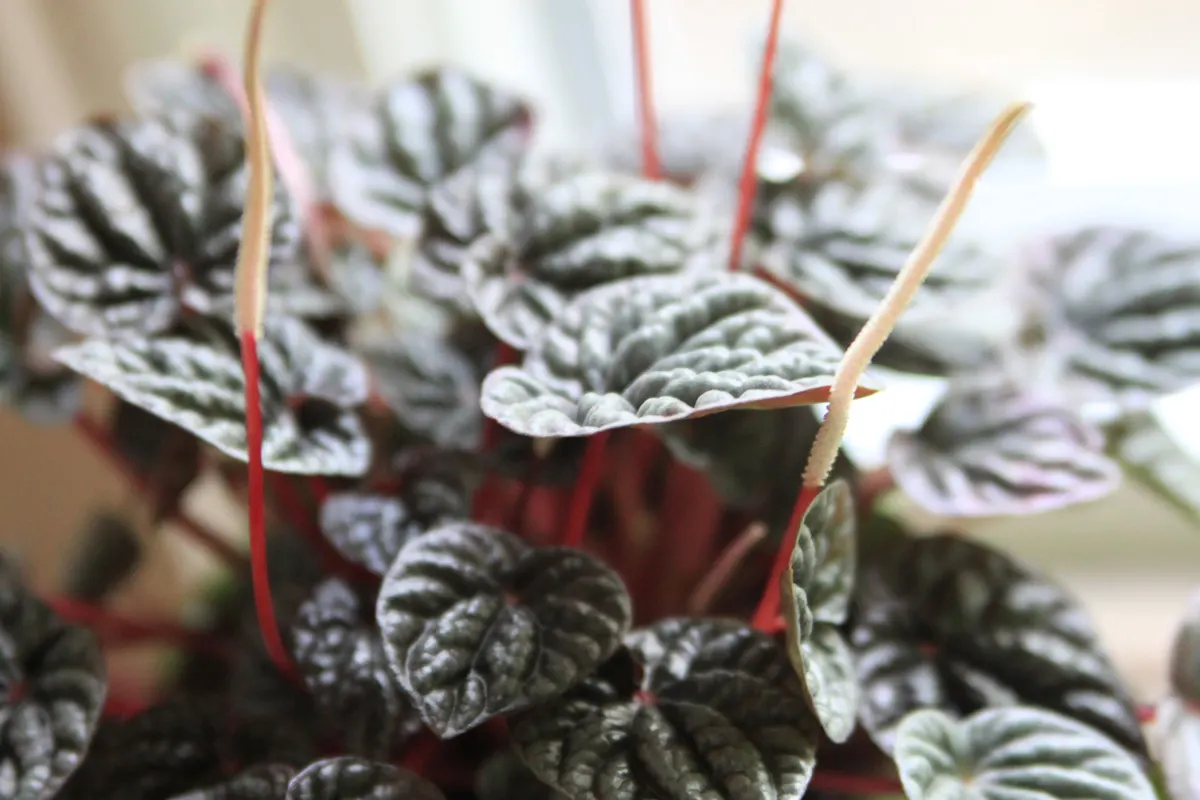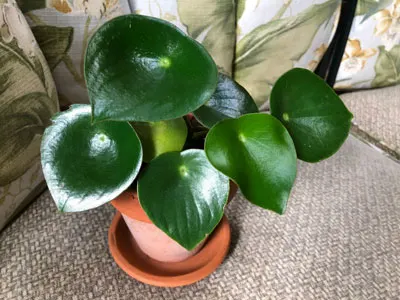Some of the links in this post may be affiliate links.
Peperomia ‘Hope’ is a delightful cultivar resulting from a cross between Peperomia deppeana and Peperomia quadrifolia. A member of the Piperaceae family (pepper family of plants), this perennial epiphyte has beautiful trailing stems with small, semi-succulent round leaves.
Since Peperomia ‘Hope’ will remain a relatively small plant, it is great for small spaces if you don’t have room for larger houseplants.
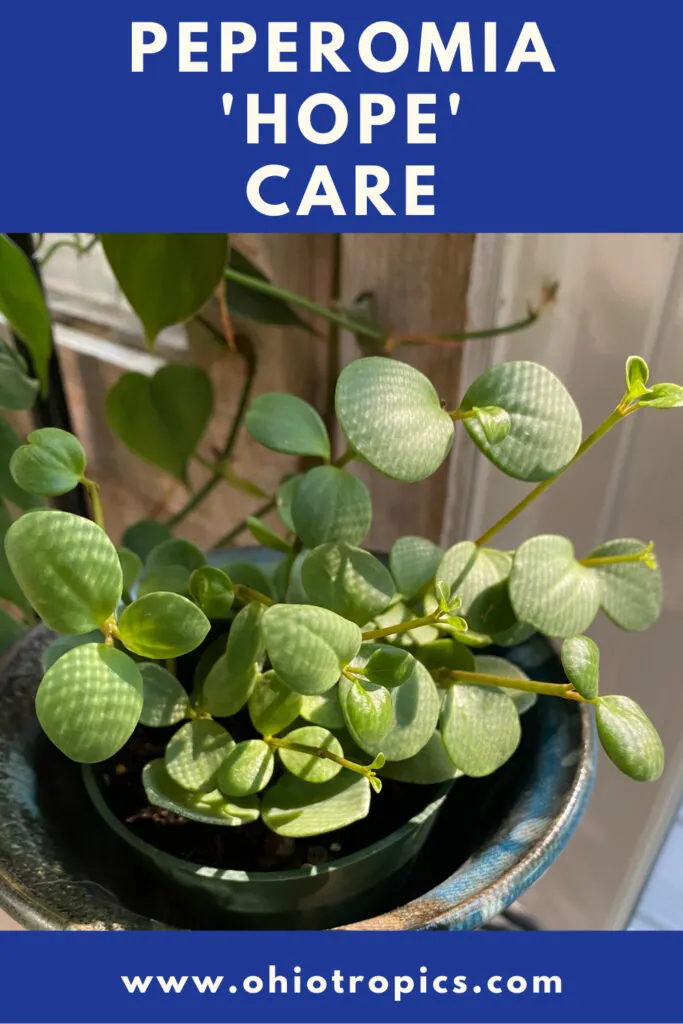
A breeding program in the Netherlands, conducted by Josephus van der Velden, resulted in the cultivar Peperomia ‘Hope’. The seed parent was Peperomia deppeana and the pollen parent was Peperomia quadrifolia.
Table of Contents
PEPEROMIA HOPE CARE
Because of its trailing stems, this plant is ideal for hanging baskets, or simply cascading from the edge of your plant shelf. It is sometimes known as trailing jade plant, though it is not a jade plant at all.
Here are 7 important points to remember in order to grow a thriving Peperomia ‘Hope’ plant.
1. LIGHT
Peperomia plants are also commonly known as radiator plants, and like any plants in the Peperomia genus, it is best to avoid placing your ‘Hope’ in a low light situation.
They will survive, but not look their best. Thin stems, small leaves and leggy growth can occur if your plant isn’t getting enough light.
Eastern or Western exposure windows would be ideal indoors. Avoid any locations that have direct sunlight all day, but some direct sun indoors is beneficial.
If you have windows that are particularly sunny, you may want to diffuse the light with sheer curtains, or set your plant back a little further from the window.
You’ll know if your plant is getting too much direct sun if all of your foliage has turned a yellowish-green color.
At a minimum, you’ll want to situate your plant immediately right in front of a window that receives bright indirect light all day, but like I mentioned, an hour or two of direct sun can be beneficial.
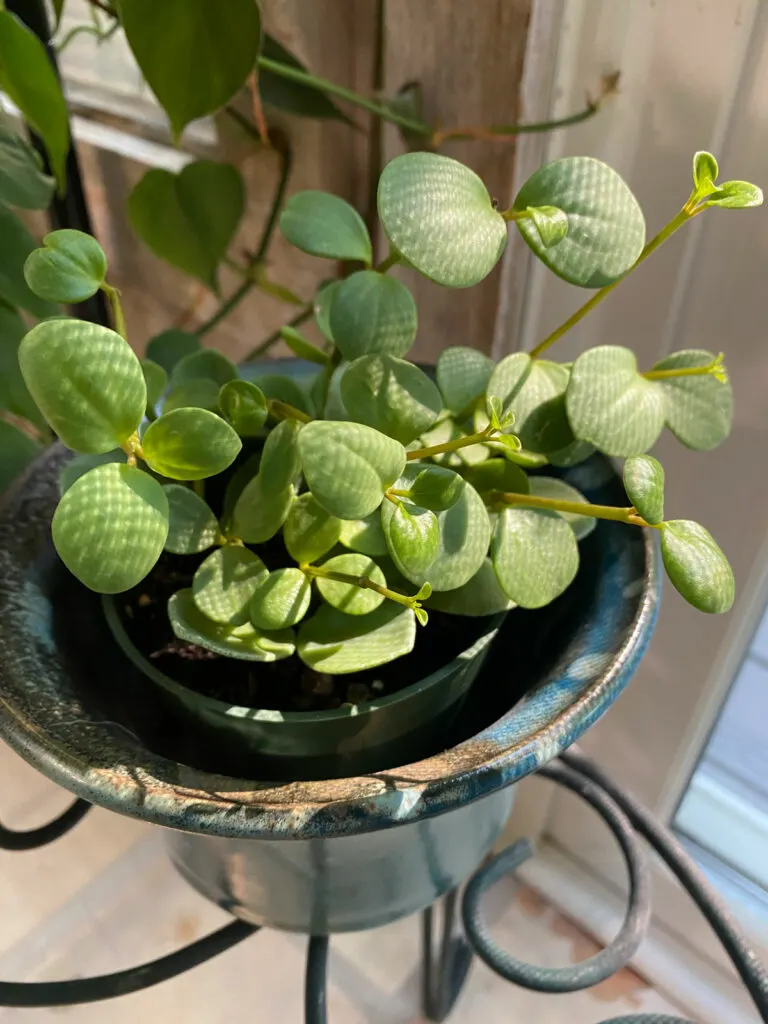
2. WATERING
Like any houseplant, proper watering techniques are an absolutely crucial factor in a maintaining a thriving ‘Hope’ plant.
Always water thoroughly and allow excess water to escape the drainage holes.
Because of the succulent leaves, Peperomia ‘Hope’ can withstand some drying out, but they do perform better if you don’t let them get completely bone dry.
Being tropical plants, they do like relatively moist soil, so I would only recommend allowing the top inch of soil to dry out before watering again. Avoid any extremes in potting mix moisture.
3. SOIL
My go-to blend for any Peperomia is to simply mix together 2 parts of an all-purpose potting mix (such as Miracle-Gro or even any cactus/succulent mix) together with 1 part of Bonsai Jack 1/4″
This blend results in very sharp drainage and makes it difficult to “overwater” and thus reducing the risk of root rot.
I’ve had great success using this mix for all my Peperomia plants.
One thing I’d like to advise against is using a moisture meter. I’ve witnessed so many people destroy their plants as a result of using moisture meters. Simply use your finger to judge soil moisture.
I wrote a whole separate post on the dangers of using soil moisture meters.
4. POT SIZE AND TYPE
Because of their small root system, you’ll want to keep your plant in a fairly small pot. When it does come time to repot, only go up one pot size.
In my personal experience, it is rare that you’ll need to go any larger than a 6 inch diameter pot.
5. FERTILIZING
Peperomia ‘Hope’ is not a heavy feeder, but regular fertilization should be part of your routine.
My favorite fertilizer to use is
I simply mix 1/4 to 1/2 teaspoon of
I like to fertilize during the active growing season and usually take a break for a couple months during the winter time when many plants aren’t growing much.
Some people prefer organic fertilizer for their plants, such as fish emulsion, but I don’t like to use this indoors because of the odor.
For houseplants that I do move outside during warmer months, I do like to use fertilizers like fish emulsion.
6. TEMPERATURE & HUMIDITY
TEMPERATURE
The native range of the “parents” of Peperomia ‘Hope’ tells us everything we need to know in terms of the temperature and humidity that the plant prefers.
One of the parent plant species, Peperomia deppeana, is native to Mexico and Central America. The other parent plant species, Peperomia quadrifolia, is native to Mexico, Central America, as well as parts of South America.
Average room temperature works just fine. Be careful not to expose your plants to any minimum temperatures below 50F (10C).
HUMIDITY
Given the natural habitat of these plants, high humidity is appreciated.
Misting will do nothing for humidity. It only wets the leaves, and if you overdo it, it can even encourage fungal disease.
The most effective way to raise humidity is by using a good humidifier. If you need a recommendation on the best humidifiers for your home, check out my post on 3 fantastic humidifiers for your indoor plants.
You can also set your plants on top of moist pebbles as well. For a more detailed discussion on humidity, read my post on how to increase humidity for houseplants.
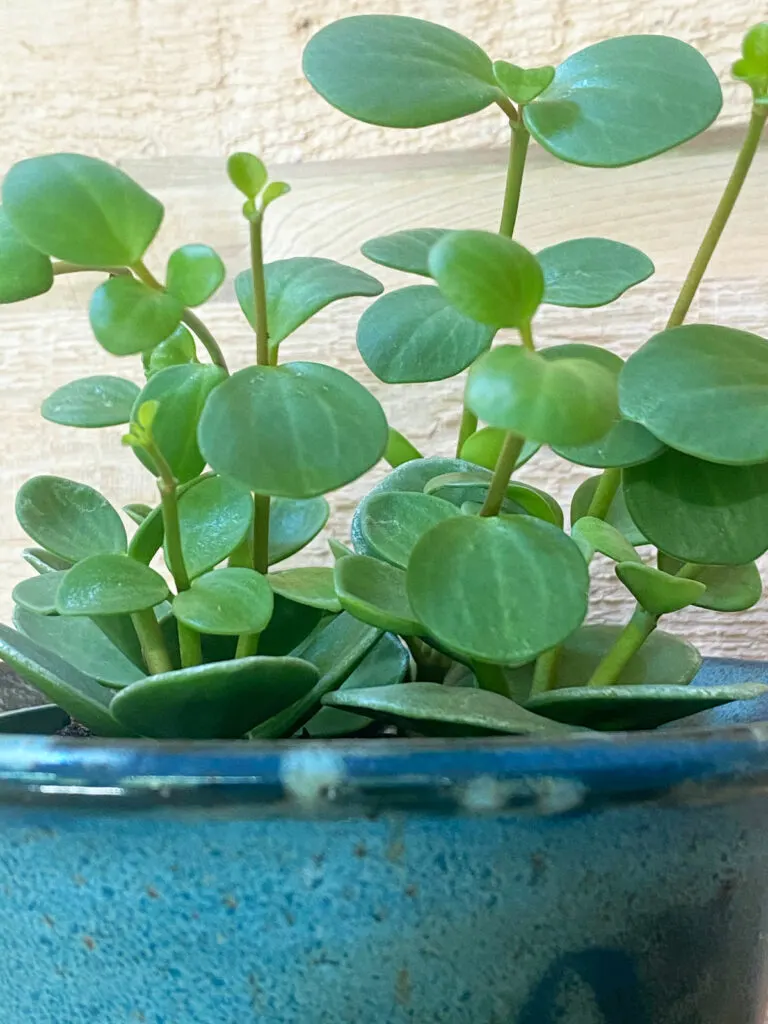
7. PROPAGATION
You can easily propagate using either stem cuttings or leaf cuttings. The best time to propagate would be during seasons of active growth. Spring and summer time would be the best times, but you can still have success year-round if your growing conditions are good and you have sufficient light.
STEM CUTTINGS
Simply take a cutting that is 2-3″ long or so. You’ll want to cut immediately below a node (where the leaves meet the main stem).
At this point, you can place the cutting in water, wait for roots to grow and then plant, or place directly into potting mix. You’ll want to make sure that the node is in water or in soil in order for the roots to grow.
LEAF CUTTINGS
Simply remove a leaf, with the petiole attached, and insert into moist potting mix (petiole end into the soil and insert just enough so that the leaf is stable). Keep it in a warm, bright location (with not too much direct sun), and new growth will emerge.
Increasing humidity is very beneficial when rooting cuttings. An easy way to do this is to simply cover your cuttings with a clear plastic bag. Once your cuttings are showing signs of growth, you can remove the bag.
If you use the plastic bag method, just be very cautious to not expose your cuttings to root much direct sun otherwise your cuttings will cook!
COMMON PROBLEMS & QUESTIONS
Is Peperomia ‘Hope’ poisonous to pets?
According to the ASPCA, Peperomia plants are non-toxic to cats and dogs.
Why are my Peperomia ‘Hope’ leaves falling off?
Many factors can be at play here. Cold temperatures or cold drafts, as well as extremes in soil moisture (either too dry or too wet) can cause sudden leaf drop in your plant.
Why is my Peperomia ‘Hope’ leggy?
If your plant is stretching out and isn’t as full as it used to be, your plant is likely not getting enough light. Increase the amount of light and you may also want to prune your plant slightly back to encourage a more bushy plant.
Why are my Peperomia ‘Hope’ leaves curling?
Typically, curling leaves are caused by inconsistent soil moisture. If your soil moisture levels tend to be erratic and not consistent, try and avoid your potting mix from getting completely dry or staying too wet. Wait until the top inch or so is dry and then water. Be sure to also regularly fertilize your plant and follow all the care instructions in this post.
Does Peperomia Hope flower?
Yes it does. The flower spike are long, which is very characteristic of the Piperaceae family, but the actual flowers themselves are tiny flowers that appear on the main spike.
If you are enamored by Peperomia plants like I am, be sure to check out my posts on other Peperomia varieties such as Watermelon Peperomia, Peperomia caperata, Peperomia obtusifolia, Peperomia prostrata (string of turtles), Peperomia puteolata, Peperomia polybotrya (raindrop peperomia), Peperomia perciliata, and Peperomia ‘Ruby Cascade’.

